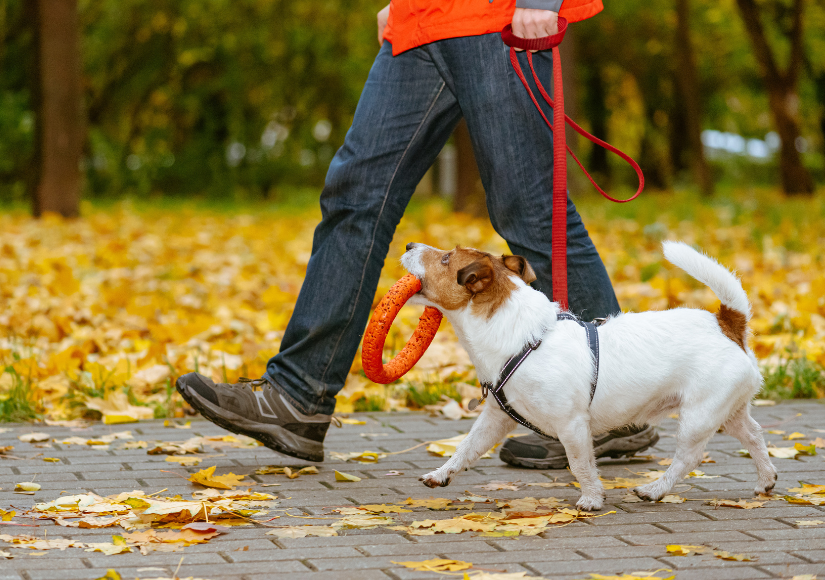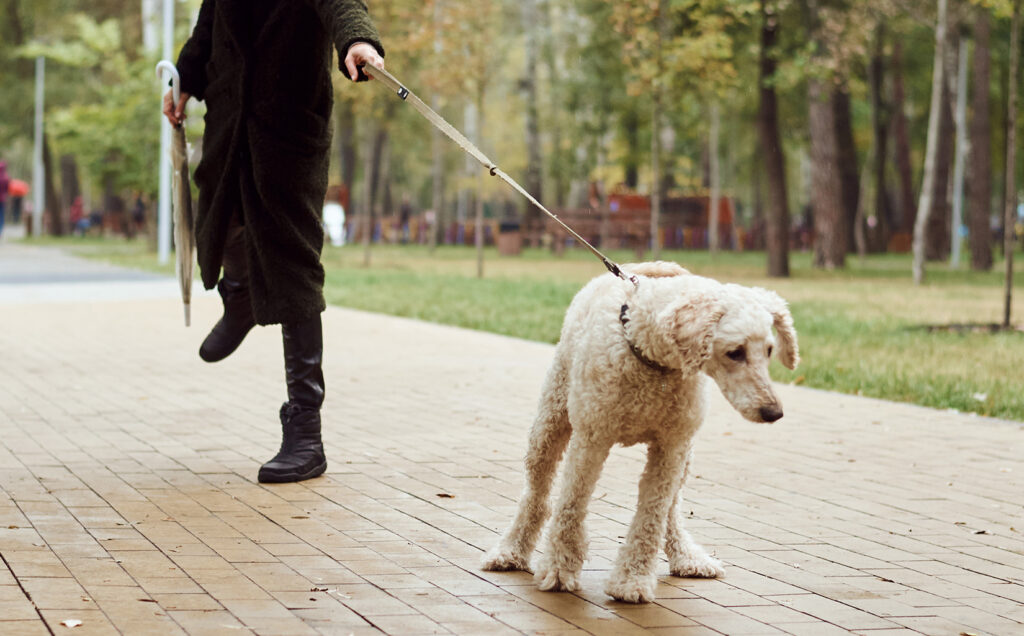All about loose leash walking
There are two groups of dog guardians: those who enjoy going for a walk with their dogs and guardians of dogs who pull on a leash.
Going for a walk with a dog who pulls can be frustrating for both dog and guardian. The good news is that you can train your dog to walk on a loose leash, and the process is even fun!
We asked AnimalKind trainers about leash walking and the steps to train your dog to walk on a loose leash.
Here is all the helpful information they share so you get answers to questions like:
- What is loose leash walking?
And how do you know your dog is ready for loose leash walking? - What equipment do you need for loose leash walking?
- Training your dog to walk on a loose leash
- How do you get your dog ready for training?

1. What is loose leash walking?
Loose leash walking is when you are walking with your leashed dog without tension on the leash. You and your dog are relaxed, and the leash is also relaxed.
How do you know your dog is ready for loose leash walking?
Being ready might look different for everyone, depending on each dog’s specific situation.
Consider the environment and how your dog reacts to certain things within that environment. Think of where you’ll be walking, how your dog will respond to the distractions you might encounter, and the potential of bumping into something your dog might be afraid of.
No dog magically turns into a loose leash walking star just by putting them on a leash. So before you start, ask yourself, is this an environment that will help your dog succeed in loose leash training? Or should you wait? According to Lisbeth Plant at Cowichan Canine, “If you walk in a non-distracting environment, a natural environment, nobody else around, you can start right away.”
2. What equipment do you need for loose leash walking?
According to Maren Bruun of Paw in Hand, there are three essentials to enjoying a loose-leash walk with your dog:
- Long leash
- Well-fitted harness
- Treat pouch with lots of treats
Long leash
Bruun says, “you want a long leash as long as you can safely and effectively handle it. You want it to be light enough weight that you can handle it in your hands with a few loops—gathering it in, letting it out as your dog wanders ahead. As they stop to sniff, they might catch up with you, gathering it again.”
Harness
Making sure you are using a well-fitted harness is essential. “The harness must be comfortable for the dog to wear. There should be no chaffing and no cinching in order to prevent the dog from pulling off the harness,” says Plant. “Cinching is unpleasant, and it’s aversive to the dog, and we don’t want to use that.”
Correctly fitting the harness also allows your dog to comfortably move. Bruun says, “You want a well-fitted, secure, comfortable harness—one with two attachment points, one on the front, one on the back. And make sure there is plenty of room for their legs, their shoulders, and their shoulder blades to move.”
The two attachment points can be helpful when you are struggling with a dog who tends to pull a lot. Lynn Gagnon of Stoked Dogs says, “If you are really struggling with pulling, I recommend that you invest in a good front clip harness.” The front clip helps redirect the energy of the dog pulling. “When we clip the leash to that front clip, and the dog pulls, it just kind of turns them around instead of letting the energy propel forward.”
Treat pouch
Carrying treats on your walks has many benefits. You can use them for training, but they are also useful tools to keep handy. “Some really good high-value treats cause’ there is a lot of things to compete with your attention out there when you are walking,” says Bruun.
3. Training your dog to walk on a loose leash
There are fun and humane ways to train your dog to walk on a leash. Stephanie Champagne of Wild Tails explains an easy and basic 2-step method:
- Step 1: Your dog follows you as you step backwards
- Step 2: Walk forward, reward by your side
In step one, you want your dog to follow you as you step backwards. To achieve that, you take a step back, and as the dog walks toward you, you reward them. Keep repeating the same process as many times as needed.
For step two, you and your dog face the same direction. “When your dog is reliably following you when you take a step back, turn so you are facing the same direction as your dog,” says Champagne. “Take a step; reward at your side. Take a step; reward at your side.” Keep repeating by moving forward and rewarding by your side.
A helpful tip to avoid your dog tripping you when using this method is to deliver the food reward from the same side your dog is on. Champagne explains, “If you are walking with your dog on your right side, try to deliver your food rewards from your right hand. If your dog is on your right and you deliver your food rewards from your left hand, there is a chance your dog will cut in front of you, right in front of your feet and potentially trip you.”
4. How do you get your dog ready for training?
You can do a few things to help your dog be ready for loose leash training.
Make sure your dog understands the basics
Vanessa Kursan at Evolve Dog Training says you can start by teaching your dog to focus on you and stay in position by your side. Once your dog can do that, you know these are signs your dog is ready to practice loose leash walking.
Know when to add distractions
Identifying when to introduce new distractions is crucial in getting your dog ready to take the next step in their loose leash training journey. Kursan also recommends starting indoors, in a controlled environment with no distractions. Once your dog is comfortable, you move the training to an environment with a few distractions. “I usually like to start with a parking lot or a park, with less distraction than usual,” says Kursan, “and as your dog gets better at loose leash walking, you can increase the distraction and support him in being a good leash walker.”
Let your dog release some energy
At the beginning of your walk, your dog is full of excitement. Getting them to focus on training when they have so much energy might be setting them, and you, up for failure.
You can help your dog be ready for training by letting them release some of that energy first and leaving the training for the end of the walk. Gagnon explains, “You know how your puppy is. You leave the door, and your puppy is like, oh, my god! I’ve got to check out everything. I’ve got to sniff here, run over here.” Gagnon suggests, “instead, start at the end of your walk. If you live in a residential neighbourhood, maybe the last block before your home.” That way, you are allowing your dog to get their energy out before training begins, making them more likely to focus.
What about stopping your dog from pulling?
Yes! Learn why dogs pull and how to stop your dog from pulling on a leash with helpful tips and advice from AnimalKind trainers.
Your next relaxing and enjoyable walk with your dog is just a quick read away.
